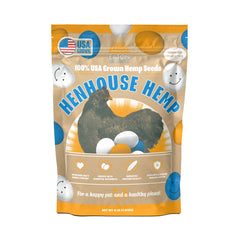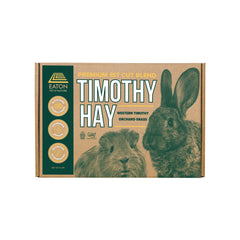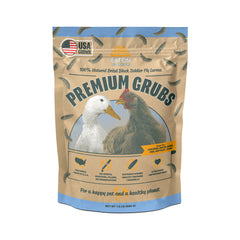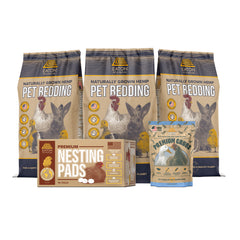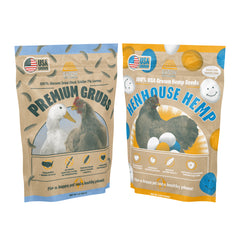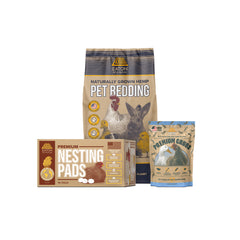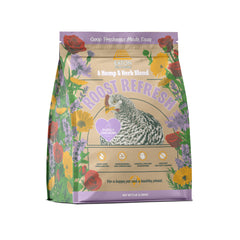Winter mornings on the homestead start early—there’s no sleeping in when you’ve got animals depending on you. After getting the kids off to school, I bundle up in my warmest insulated overalls, then head out to face the cold.
Chores in the winter months are no joke! Feeding pigs, cows, and chickens, breaking ice in water troughs, milking the cows, and processing the milk—it’s a full morning before I can finally come inside to thaw out.
Don’t get me wrong, I love it, even when my fingers feel like popsicles and my eyelashes are frosty. But caring for animals in winter takes extra effort, especially the chickens. We have 16 ladies plus their handsome roo. They are a barnyard mix of young pullets, seasoned layers to our old fluffy Bielefelder hen, Granny, who’s 5 years old and still running the show. Over the years, I’ve learned what works to keep them healthy and happy during the cold months, and I’m excited to share my tips with you!
Cold Weather Coop Prep
A good coop is your first defense against cold weather. Ours is spacious with four nesting boxes, plenty of roosting space, and a big run. In winter, I seal up any drafts but keep the ventilation open for airflow. Chickens breathe out a surprising amount of moisture, and if that builds up, frostbite can happen fast without good ventilation. Remember that heat rises, so the top of the coop (which is likely where your pet chicken roosts) is going to be warmer in the cold winter temperatures than the lower level.
I have a few of my favorite coop supplies arriving monthly on autoship- the Ultimate Coop Bundle including hemp bedding, premium grubs and aspen nesting pads. Here’s how I use them!
We also use the deep litter method to provide extra bedding during winter. Basically, you let a thick layer of hemp bedding build up on the floor of the coop, kind of like layering lasagna over the span of a few months. I also add chopped herbs from the garden or Roost Refresh sprinkled around the floor of the coop.
The chickens’ scratching keeps it mixed, and the composting action generates a little extra heat. Plus, it’s one less thing to clean in the cold—win-win! And in the spring, I can take all of that old bedding and begin the process of turning it into black gold- aka, garden compost.
Outside the coop, we stack hay bales as windbreaks to protect the north side of the run from cold wind. The straw bales are ultra insulating, and provide a wind break from the harshest winter storms. In the event of blowing or drifting snow, it also provides good protection.
The nesting boxes aren’t very protected from drafts, as the entrance to each box is wide open. One thing I do to help keep the ladies warm while they tend to business is layer aspen nesting pads. Unless the old nesting pad is visibly soiled, I just stack the new one on top of it– a deep litter method (or maybe I should say a cushy-cozy pad method!) of sorts. The fluffy pads also protect eggs from breaking in the cold if they get a little frozen and are shuffled against each other while the hens settle in.

Feed & Water
When it’s cold, chickens need extra calories to stay warm. I add a scoop of hemp seeds, sunflower seeds, scratch grains or cracked corn to their afternoon scratch. On extra chilly mornings, I’ll mix up a warm oatmeal mash with a sprinkle of cayenne pepper. Chickens can’t taste the spice, but the pepper gets them warming up from the inside out! I also supplement their daily feed with extra kitchen scraps and premium grubs. I just toss a few handfuls to them as I’m gathering eggs and checking on their food and water.
Keeping their water bowl from freezing is always a challenge. If you don’t have heated waterers, you’ll need to swap out the waterers for fresh water at least twice a day. It’s not glamorous, but it’s necessary. I keep one in the warm shed to thaw, while the other is in the coop slowly freezing.
I do have a heated galvanized base with a 5 gallon metal waterer, and I will run an extension cord and use it during the coldest days, or if I’m going to be away from the homestead for more than half a day.
Healthy Hens
Frostbite can be an issue on combs and wattles, especially for breeds with larger combs. It's a good idea to put a little dab of coconut oil or Vaseline before a cold snap can help protect those sensitive areas. The only time we’ve experienced frost bite on our zone 6B homestead was when we had an arctic blast that lasted for more than a week, with blowing cold well below zero degrees Fahrenheit. Our rooster suffered the most, his comb and wattles taking months to recover.
And if any of your hens are still molting when the temperatures drop, they’ll need extra protein and maybe a little extra feed while they grow new feathers. Mealworms or scrambled eggs (yes, chickens will eat eggs!) are great treats to help them out.
I also watch closely for health issues, such as respiratory problems. This time of year your hens are spending most of their energy on generating a lot of body heat, and this can take a toll on their immune system. But don't worry! In all of my years of keeping chickens, I've found that providing a healthy coop environment and plenty of food keeps my chickens healthy and happy in colder temperatures.

Keep Them Active
Bored chickens are unhappy chickens, and in winter, they don’t have as much to do. We toss scraps or leaves into the run for them to scratch around in, which keeps their little dinosaur brains occupied.
I’ll also scatter grub treats or herbs around the run to encourage movement, which helps them stay warm. Chicken keepers can think of all kinds of ways to keep their feathered friends occupied during the cold days!
Cold Hardy Chicken Breeds
Some chickens are just built for the cold better than others. Like I mentioned above, my flock is a barnyard mix. We've always kept a rooster, and if one of our hens goes broody, we let her hatch her clutch of eggs. Rather than having specific breeds of chickens, as we jokingly say, our are all full of that hybrid vigor.
If you're growing your flock from scratch and live somewhere with below freezing temperatures, you might consider cold-hardy breeds like Plymouth Rock, Buff Orpington, and Marans. Some breeds, like Brahmas and Faverolles, even have feathered feet! Yes, your chickens' feet can also be a factor in how well they tolerate cold temperatures!

What to Avoid
One thing we don’t do? Use heat lamps. They’re a huge fire hazard and not necessary. Chickens are naturally insulated with all those feathers, and as long as they can huddle together on the roost, they’ll stay cozy.
I’m overly cautious about using added heat or extension cords in my coop– there are many stories of fires that occur when the hens get too rowdy and tip over heat lamps and such. In MOST situations, heat lamps are discouraged. Think of the birds in your yard or cold climates, do they need a heat lamp to survive the winter? Chances are your flock doesn’t, either!
Caring for chickens in winter is all about preparation and a little extra attention. Our sweet Granny and her friends handle the cold just fine with these simple steps, and there’s something so peaceful about a flock of content, fluffy hens in the fresh air of a snowy yard.
Plus, they still occasionally give us eggs—my daily reminder that even in the quiet of winter, life keeps ticking along. And if your egg supply has dwindled down to nothing, don’t worry. It’s perfectly normal for your chickens to take a winter break and the egg production will start back up in the spring as they get more hours of light during the day. How do you keep your flock warm?
Share your tips in the comments!
